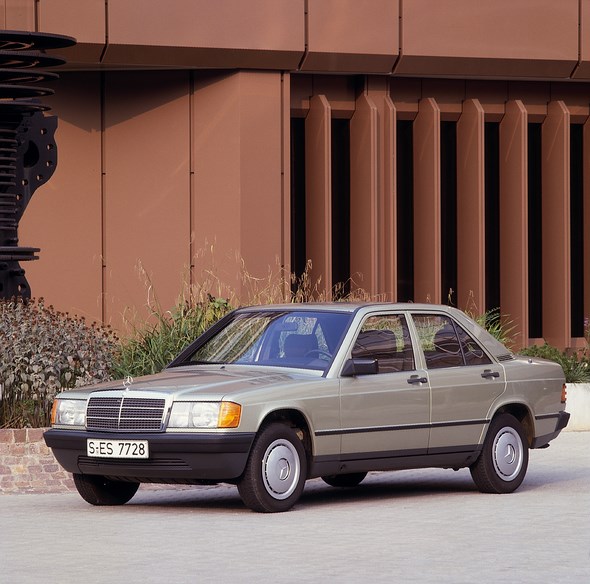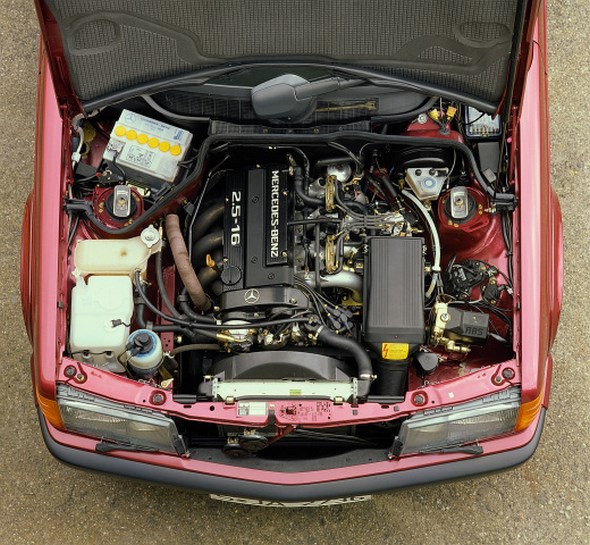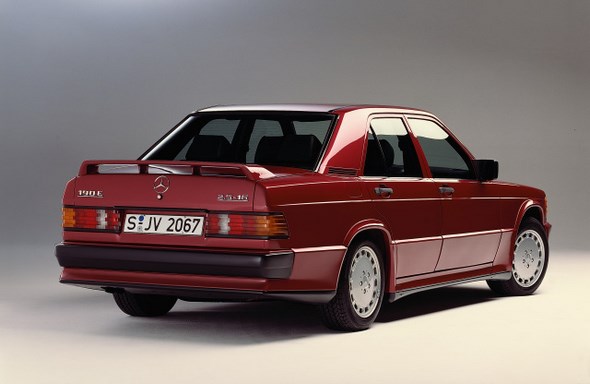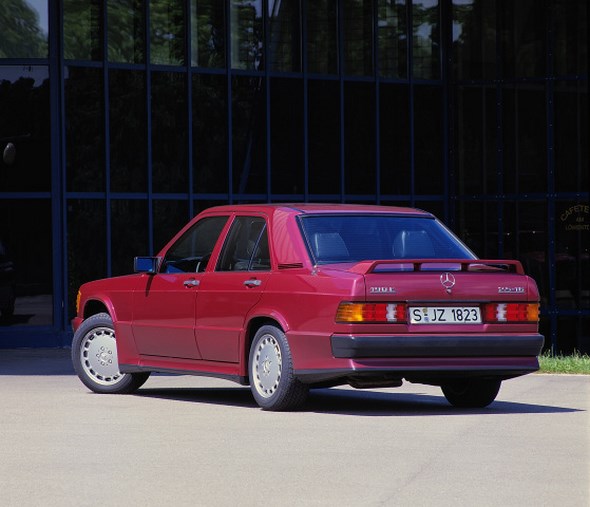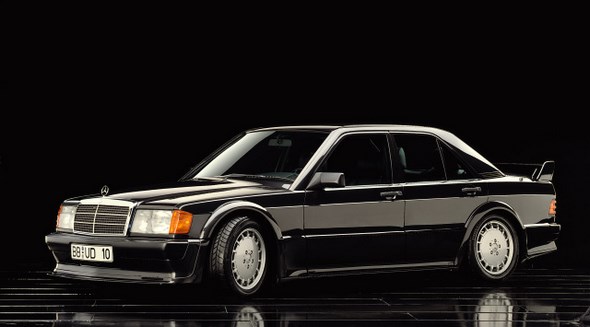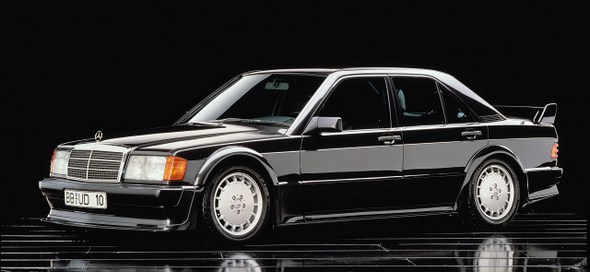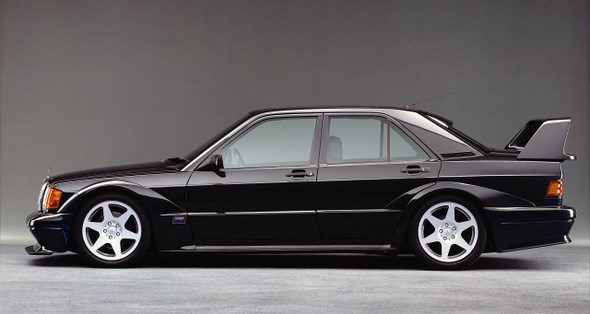Mercedes W201 190 1982 – 1992
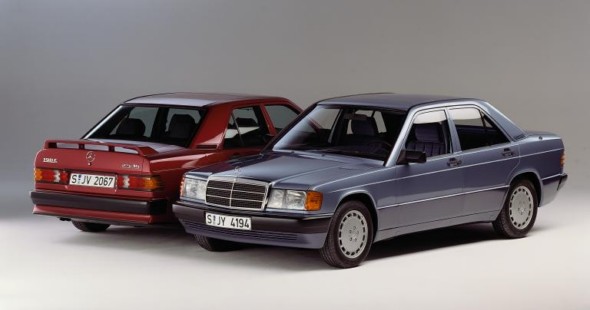

The public and the press were looking towards December 8, 1982 with great expectations, when the compact-class sedans Type 190 and 190 E were presented.
These models did not replace previous types, but completed the traditional Mercedes-Benz passenger car program by a third main line.
The new range of models was characterised by more compact measures, reduced weight and increased economy without making any compromises as to handling performance, safety and reliability.

Minimised energy consumption was reached by using high-strength sheet steel and other weight- reducing materials as well as by aerodynamic optimisation.

Passive safety had been the reason for providing series 126 with a forked beam in the front end.

With this design principle also the compact-class vehicles fulfilled the criterion of an asymmetric head-on impact with 40 % overlapping and 55 kph. Thus the 190 models were absolutely as safe as the big S-Class sedans.

Excellent handling performance was made possible by newly developed front and rear axle constructions.

The damper strut front axle with individual A-arm suspension and anti-dive device guarantees a good straight-running stability.

Its low overall height created favourable conditions in the engine compartment. A revolutionary novelty was the multilink rear suspension, in which each rear wheel is led by an independent control arm.
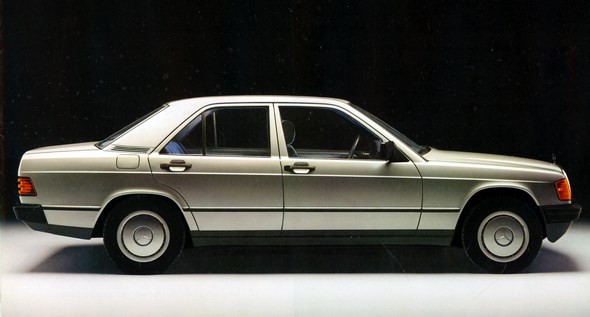
This optimal wheel control largely compensates lateral and longitudinal forces at all driving conditions, thus avoiding unwanted steering movements of the wheel.

Further advantages of this innovative construction are its low weight and the little space it takes. On account of their parking brakes the compact-class types held a special position.

After all new passenger car models since 1968 had been equipped with a foot-operated variant, due to lack of space a conventional hand brake between the front seats was now used again.
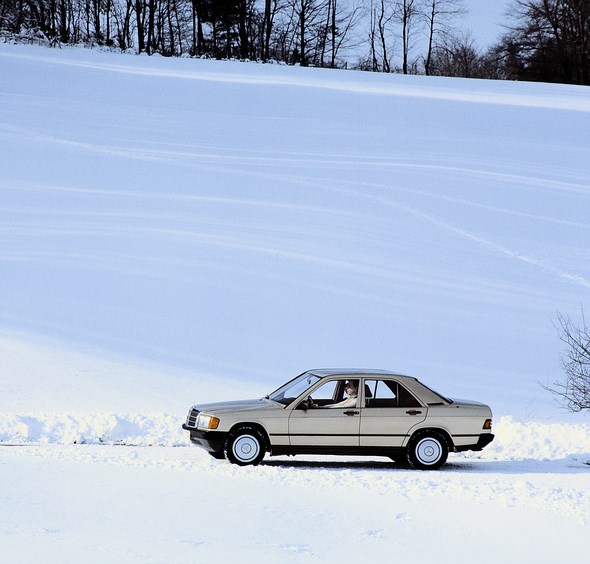
The production of the compact-class sedans was first carried out in Sindelfingen. From November 1983 on, also parallel at the plant in Bremen, which had been largely and with high investments expanded for that purpose.

However, the former Borgward plant Bremen-Sebaldsbrück, where already from the beginning of 1978 the 123 series station wagons had been built, did not function as a pure assembly plant, but was linked to Sindelfingen in flexible production union.

This way of co-operation, which for the first time in the history of the company had been practised at such a large extent, was characterised by a reciprocal delivery of body components.
In Bremen the engine bonnet, the floor assembly, the fuel tank and the doors were produced.

In Sindelfingen all other parts of sheet panels were made. Both plants received their engines, gear boxes and axles as usual from Untertürkheim.
Originally, series 201 only comprised the 190 and 190 E models, which had been equipped with 2.0-liter 4-cylinder engines.
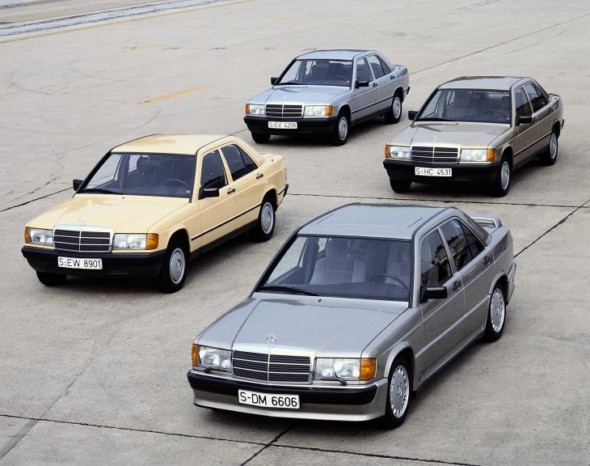
Both aggregates belonged to the engine family M 102 and were based on the unit that had been used for two and a half years in Type 200.
Type 190 had a carburettor engine which by reducing the inlet and oulet passages as well as by using a modified camshaft and smaller valves had been throttled from 109 hp to 90 hp.
The 190 E was, however, powered by a newly developed variant with petrol injection. It mobilised 122 hp and – for the first time in a Daimler-Benz car – was provided with the mechanically-electronically controlled injection system Bosch KE-Jetronic.

In autumn 1983 the range of models was extended by Types 190 D and 190 E 2.3-16. The 190 D was provided with a totally redeveloped 2.0-liter 4-cylinder Diesel engine.
It mobilised 72 hp and was the pre-runner of a new generation of especially economical and powerful Diesel engines.

A remarkable innovation was the encapsulation of the engine-gearbox unit, for the first time applied in a standard passenger car. Thus the sound emission of the engine was reduced by more than half.
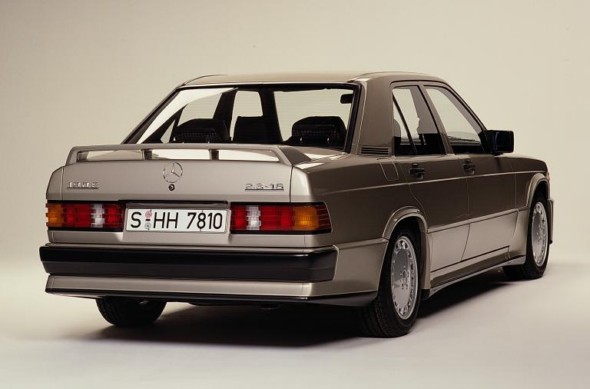
The 190 E 2.3-16 became the top model of the series. Even from the outside it differed from its less sportive brothers by a wing spoiler on the rear lid.
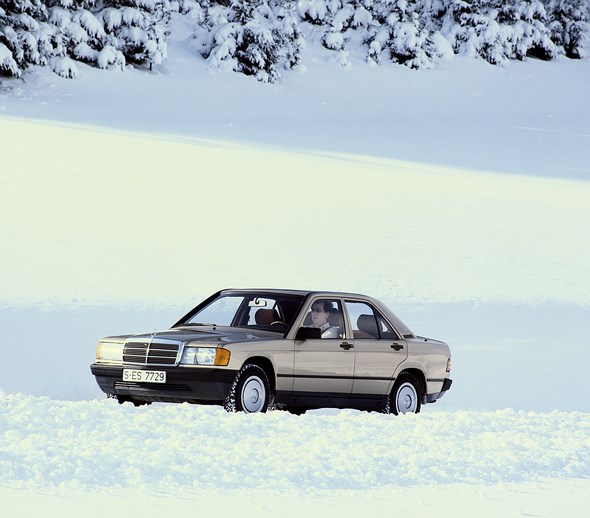
It was powered by a 2.3-liter 4-cylinder aggregate which also belonged to the engine family M 102 and had been developed from the time-tested unit of the 230 E.

A newly constructed 4-valve cylinder head and several other measures made an increase in power from 136 hp to 185 hp possible.

Even four weeks before its presentation at the Frankfurt International Motor Show IAA the new type was able to meet with sportive success.
Three prototypes on the circuit in Nardo, Southern Italy, achieved a long-distance world record of more than 25,000 km, 25,000 miles and 50,000 km with an average speed of almost 250 kph.
The standard production of the “sixteen-valve” model – which was only available in “blue-black” and “smoke-grey” – was only taken up one year later in September 1984.
From September 1983 the US market was also open to the compact-class. The 190 D 2.2 and the 190 E 2.3 were exported, two versions which were not available on the home market.

With the Diesel version the increased capacity had been obtained by increasing the stroke of the engine in order to compensate for the loss of power due to the exhaust recirculation system.
The power output was 72 hp – like the smaller version for the domestic market.. the situation with the petrol engine was similar.

The low compression version of the engine used in the 230 E had an output of 113 hp in combination with the regulated catalytic converter – almost 10 hp less than the 190 E.
A year later the 190 E 2.3 got a modified inlet manifold, a different camshaft and re-tuned fuel injection resulting in 122 hp -the same as the 2-liter model for the domestic market.
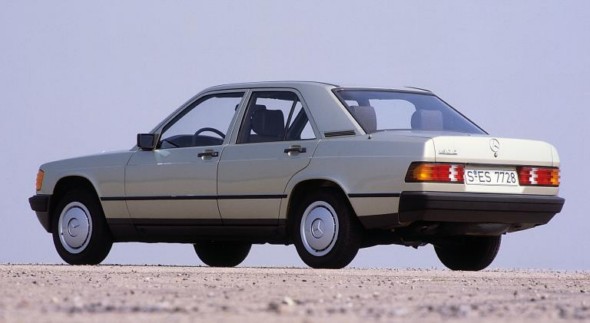
At the same time the performance of the 190 with the carburettor engine was boosted. Instead of the 90 hp engine the version from the 200 was used with slightly increased compression.
This version, known internally as the 190/1, now had 105 hp – 15 hp more than before. As part of the refinement package, both the 190 and the 190 E now included single-belt drive, hydraulic valve clearance compensation and hydraulic engine mounts.

When the medium-sized W 124 series was introduced in January 1985 all compact-class models also received 15-inch wheels, electrically heated windscreen washer jets and a windscreen wiper with cam-drive resulting in a much larger swept area.
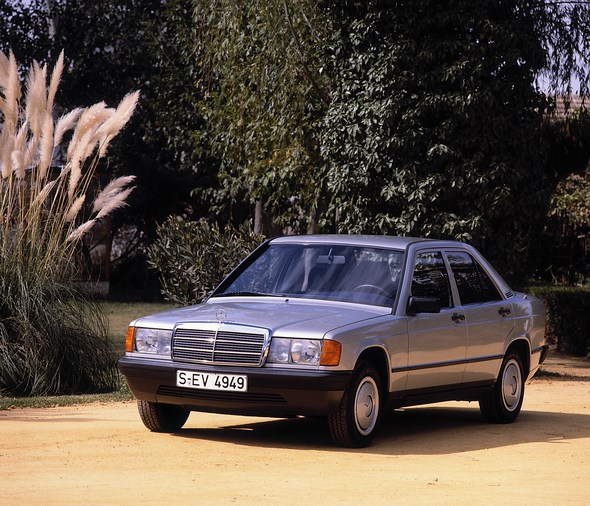
From September 1985 power assisted steering and electrically heated door mirrors were standard equipment on all models. During 1985 three new versions were added to the compact-class range.

First the 190 D 2.5 appeared in May with the economical 90 hp 5-cylinder engine from the 250 D. In addition to a new station wagon and the modified S-Class and SL model ranges, the 6-cylinder 190 E 2.6 and the 190 E 2.3 were also presented at the International Motor Show in Frankfurt in September.

The 2.3-liter 4-cylinder engine with normal compression developed 136 hp. The 2.6-liter version with the 166 hp 6-cylinder engine from the 260 E was a minor sensation due to the fact that it had been possible to fit this engine into the 190.
Series production of the 190 E 2.6 began in April 1986 and it was subsequently launched, together with the 190 E 2.3, in October that year.

Apart from the basic 190 with its carburettor engine, the other petrol-engined 190 versions were also available with regulated three-way catalytic converters.
An alternative option was the so-called “RÜF version”, without catalyst and lambda probe, but with the multi-functional fuel supply and ignition system.

This version could easily be equipped with a catalyst at a later date, an advantage for many customers as unleaded fuel was not yet available everywhere.
From September 1986 all Mercedes-Benz cars were available with a three-way catalyst, including the carburettor version of the 190.

The “RÜF versions” were still also offered, with a price reduction, until August 1989. Another version of the compact class was launched at the Frankfurt Motor Show in September 1987.
The 190 D 2.5 Turbodiesel was equipped with a 122 hp 5-cylinder engine based on the normally aspirated engine but with 32 hp more.
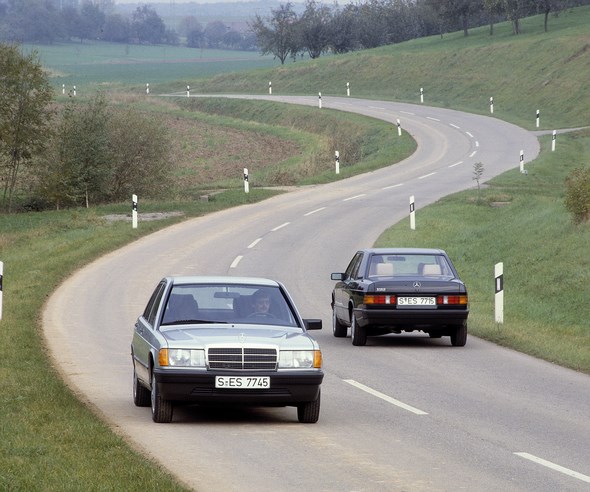
In September 1988 the face-lifted compact class was shown at the Paris Motor Show, six months after the 1,000,000th car of the 201 series had been produced in Bremen.
Read more on the W201 in the article Modern classics..

